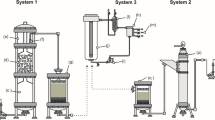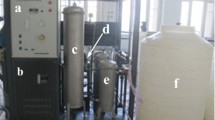Abstract
The purpose of this work was to study the efficiency of different treatments, based on the combination of O3, H2O2, and TiO2, on fresh surface water samples fortified with wild strains of Escherichia coli. Moreover, an exhaustive assessment of the influence of the different agents involved in the treatment has been carried out by kinetic modeling of E. coli inactivation results. The treatments studied were (i) ozonation (O3), (ii) the peroxone system (O3/0.04 mM H2O2), (iii) catalytic ozonation (O3/1 g/L TiO2), and (iv) a combined treatment of O3/1 g/L TiO2/0.04 mM H2O2. It was observed that the peroxone system achieved the highest levels of inactivation of E. coli, around 6.80 log after 10 min of contact time. Catalytic ozonation also obtained high levels of inactivation in a short period of time, reaching 6.22 log in 10 min. Both treatments, the peroxone system (O3/H2O2) and catalytic ozonation (O3/TiO2), produced a higher inactivation rate of E. coli than ozonation (4.97 log after 10 min). While the combination of ozone with hydrogen peroxide or titanium dioxide thus produces an increase in the inactivation yield of E. coli regarding ozonation, the O3/TiO2/H2O2 combination did not enhance the inactivation results. The fitting of experimental values to the corresponding equations through non-linear regression techniques was carried out with Microsoft® Excel GInaFiT software. The inactivation results of E. coli did not respond to linear functions, and it was necessary to use mathematical models able to describe certain deviations in the bacterial inactivation processes. In this case, the inactivation results fit with mathematical models based on the hypothesis that the bacteria population is divided into two different subgroups with different degrees of resistance to treatments, for instance biphasic and biphasic with shoulder models.

ᅟ




Similar content being viewed by others
References
Albert I, Mafart P (2005) A modified Weibull model for bacterial inactivation. Int J Food Microbiol 100:197–211
Bancroft KP (1984) Ozonation and oxidation competition values. Water Res 18:473
Bigelow WD, Esty JR (1920) The thermal death point in relation to typical thermophylic organisms. J Infect Dis 27:602
Casteel MJ, Sobsey MD, Arrowood MJ (2000) Inactivation of Cryptosporidium parvum oocysts and other microbes in water and wastewater by electrochemically generated mixed oxidants. Water Sci Technol 41(7):127–134
Cerf O (1977) A review: tailing of survival curves of bacterial spores. J Appl Bacteriol 42:1–19
Chiang Y, Liang Y, Chang C, Chao A (2006) Differentiating ozone direct and indirect reactions on decomposition of humic substances. Chemosphere 65(11):2395–2400
Cho M, Yoon J (2006) Enhanced bactericidal effect of O3/H2O2 followed by Cl2. Ozone Sci Eng 28:335–340
Chong MN, Jin B, Saint CP (2011) Bacterial inactivation kinetics of a photo-disinfection system using novel titania-impregnated kaolinite photocatalyst. Chem Eng J 171:16–23
Coroller L, Leguerinel I, Mettler E, Savy N, Mafart P (2006) General model, based on two mixed Weibull distributions of bacterial resistance, for describing various shapes of inactivation curves. Appl Environ Microbiol 72(10):6493–6502
Council Directive 98/83/EC of 3 November 1998 on the quality of water intended for human consumption
Dalrymple OK, Stefanakos E, Trotz MA, Goswami DY (2010) A review of the mechanisms and modelling of photocatalytic disinfection. Appl Catal B Environ 98:27–38
Eaton AD, Clesceri LS, Rice EW, Greenberg AE, Franson MAH (2005) Standard methods for the examination of water and wastewater, 21st edn, APA-AWWA-WEF
Fernández-Ibáñez P, Sichel C, Polo-López MI, de Cara-García M, Tello JC (2009) Catal Today 144:62–68
Finch GR, Yuen WC, Uibel BJ (1992) Inactivation of Escherichia coli using ozone and ozone-hydrogen peroxide. Environ Technol 13:571–578
Geeraerd AH, Valdramidis VP, Van Impe JF (2005) GInaFiT, a freeware tool to assess non-log-linear microbial survivor curves. Int J Food Microbiol 102:95–105
Geeraerd AH, Valdramidis VP, Van Impe JF (2006) Erratum to “GInaFiT, a freeware tool to assess non-log-linear microbial survivor curves”. Int J Food Microbiol 110:297
Gracia R, Cortés S, Sarasa J, Ormad P, Ovelleiro JL (1999) Tratamientos oxidativos en la potabilización del agua. La ozonización catalítica como técnica complementaria a la cloración. Tecnología Agua 188:34–44
Hoigné J, Bader H (1977) The role of hydroxyl radical reactions in ozonation processes in aqueous solutions. Water Res 10:377–386
Hoigné J, Bader H (1983) Rate constants of reactions of ozone with organic and inorganic compounds in water. II. Dissociation organic compounds. Water Res 17:185–194
Hom LW (1972) Kinetics of chlorine disinfection in an ecosystem. J Sanit Eng Div 98(1):183–193
Hunt NK, Mariñas BJ (1999) Inactivation of Escherichia coli with ozone: chemical and inactivation kinetics. Water Res 33(11):2633–2641
Kositzi M, Poulios I, Malato S, Caceres J, Campos A (2004) Solar photocatalytic treatment of synthetic municipal wastewater. Water Res 38:1147–1154
Kuo CH, Zhong L, Zappi ME, Hong AP (1999) Kinetics and mechanism of the reaction between ozone and hydrogen peroxide in aqueous solutions. Can J Chem 77:473–482
Lanao M (2012) Investigación de la inactivación de Clostridium perfringens y Enterococcus sp. en aguas mediante procesos convencionales y avanzados de oxidación. Doctoral Thesis. Universidad de Zaragoza
Lanao M, Ormad MP, Ibarz C, Miguel N, Ovelleiro JL (2008) Bactericidal effectiveness of O3, O3/H2O2 and O3/TiO2 on Clostridium perfringens. Ozone Sci Eng 30:431–438
Lanao M, Ormad MP, Goñi P, Miguel N, Mosteo R, Ovelleiro JL (2010) Inactivation of Clostridium perfringens spores and vegetative cells by photolysis and TiO2 photocatalysis with H2O2. Sol Energy 84:703–709
Lanao M, Ormad MP, Mosteo R, Ovelleiro JL (2012) Inactivation of Enterococcus sp. by photolysis and TiO2 photocatalysis with H2O2 in natural water. Sol Energy 86:619–625
Mafart P, Couvert O, Gaillard S, Legurinel I (2002) On calculating sterility in thermal preservation methods: application of the Weibull frequency distribution model. Int J Food Microbiol 72:107–113
Marugán J, van Grieken R, Pablos C, Satuf ML, Cassano AE, Alfano OM (2013) Modeling of a bench-scale photocatalytic reactor for water disinfection from laboratory-scale kinetic data. Chem Eng J 224:39–45
Marugán J, van Grieken R, Pablos C, Satuf ML, Cassano AE, Alfano OM (2014) Kinetic modelling of Escherichia coli inactivation in a photocatalytic wall reactor. Catal Today. Accepted, In Press
Matamoros M, Mujeriego R, Bayona JM (2007) Trihalomethane occurrence in chlorinated reclaimed water at full-scale wastewater treatments plants in NE Spain. Water Res 41:3337–3344
Moriñigo MA, Córnax R, Muñoz MA, Romero P, Borrego JJ (1990) Relationships between Salmonella spp. and indicator microorganisms in polluted natural waters. Water Res 24(1):117–120
Nimrata KH, Mariñas BJ (1999) Inactivation of Escherichia coli with ozone: chemical and inactivation kinetics. Water Res 33(11):2633–2641
Oppenländer T (2003) Photochemical purification of water and air. Edición Wiley-VCH, Germany, ISBN 35-2730-563-7
Rincón AG, Pulgarín C (2004) Appl Catal B Environ 51:283–302
Rizzo L, Sannino D, Vaiano V, Sacco O, Scarpa A, Pietrogiacomi D (2014) Effect of solar simulated N-doped TiO2 photocatalysis on the inactivation and antibiotic resistance of an E. coli strain in biologically treated urban wastewater. Appl Catal B Environ 144:369–378
Rodríguez-Chueca J, Mosteo R, Ormad MP, Ovelleiro JL (2012) Factorial experimental design applied to Escherichia coli disinfection by Fenton and photo-Fenton processes. Sol Energy 86:3260–3267
Rodríguez-Chueca J, Polo-López MI, Mosteo R, Ormad MP, Fernández-Ibáñez P (2014) Disinfection of real and simulated urban wastewater effluents using mild solar photo-Fenton. Appl Catal B Environ 150–151:619–629
Staehelin J, Hoigné J (1982) Decomposition of ozone in water: rate of initiation by hydroxide ions and hydrogen peroxide. Environ Sci Technol 16(10):676–681
Sun J, Sun S, Fan M, Guo M, Qiao L, Sun R (2007) A kinetic study on the degradation of pnitroaniline by Fenton oxidation process. J Hazard Mater 148:172–177
UNE-EN ISO 5667–3:2012 (2012) Water quality - sampling - part 3: preservation and handling of water samples
UNE-EN ISO 9308–1 (2001) Enumeration of Escherichia coli and coliform bacteria - part 1: membrane filtration method
Wu DH, You H, Zhang R, Chen C, Lee DJ (2011) Ballast waters treatment using UV/Ag-TiO2 + O3 advanced oxidation process with Escherichia coli and Vibrio alginolyticus as indicator microorganisms. Chem Eng J 174(2–3):714–718
Zhou H, Smith DW (1995) Evaluation of parameter estimation methods for ozone disinfection kinetics. Water Res 29(2):679–686
Acknowledgments
The authors wish to express their thanks for funding obtained by the consolidated research group T33 from DGA-FSE and MICINN-FEDER through the project “Regeneración de aguas depuradas mediante procesos de oxidación avanzada (CTM2008-01876/TECNO).” The authors also thank the regional government of Aragón for a Ph.D. grant awarded to Jorge Rodríguez-Chueca.
Author information
Authors and Affiliations
Corresponding author
Additional information
Responsible editor: Michael Matthies
Highlights
• The disinfection of E. coli in fresh surface water samples was evaluated.
• The treatment of water with O3, TiO2 or/and H2O2 is an alternative to chlorination.
• Peroxone system and catalytic ozonation reached the best inactivation results.
• GInaFiT tool allows studying the kinetic modeling of the E. coli inactivation.
• E. coli population is divided into two subpopulation groups with different resistance.
Rights and permissions
About this article
Cite this article
Rodríguez-Chueca, J., Ormad Melero, M.P., Mosteo Abad, R. et al. Inactivation of Escherichia coli in fresh water with advanced oxidation processes based on the combination of O3, H2O2, and TiO2. Kinetic modeling. Environ Sci Pollut Res 22, 10280–10290 (2015). https://doi.org/10.1007/s11356-015-4222-3
Received:
Accepted:
Published:
Issue Date:
DOI: https://doi.org/10.1007/s11356-015-4222-3




